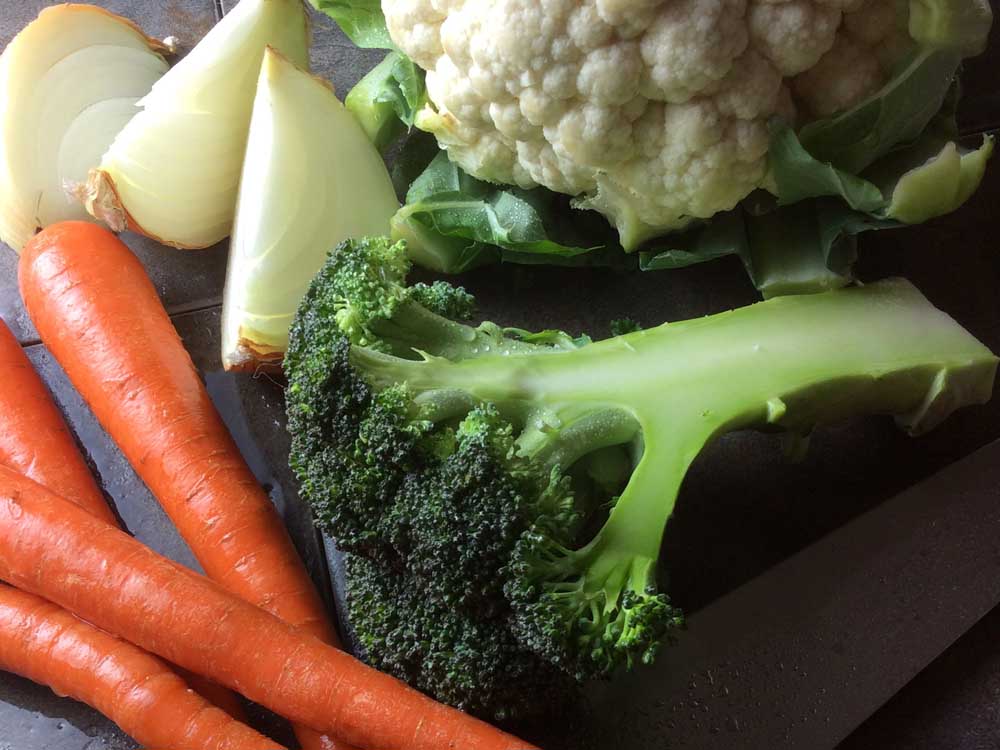Be a clean cook with 4 steps to food safety
Published 12:00 am Tuesday, February 2, 2016

- Jan Roberts-Dominguez / For The BulletinRinse all fresh fruits and vegetables under running tap water, including those with skins and rinds that are peeled away, before preparing.
Couldn’t you just die? Hours after an evening of food and fellowship and members of the parish have gone from well to wretched — and retching — because of your chicken casserole.
It’s every cook’s nightmare, but one that can usually be avoided.
First you must face up to one of life’s realities: Bacteria are everywhere. Even in your so-clean-you-can-eat-off-the-floor kitchen. Your job is to keep those little carriers of pain and misery from running amok on the food you serve.
What better time to review the basic rules of food safety than at the beginning of the year? Once you’ve perused the list, take a look at the accompanying recipes. If you’re looking for some new and fresh ideas for upcoming potluck dinners, these may be the ones. They’re easy to throw together, many can be prepared in advance and all rely on fresh ingredients so YOU control the sodium and fat content.
The guidelines
Basic food safety guidelines fall into four categories: clean, separate, cook and chill (or heat!).
1. Clean
• Wash hands and work surfaces often.
• If you have an infectious disease, don’t handle food for other people.
• Always work with clean hands, hair and fingernails.
• While working with food, you need to rewash your hands after you have: smoked; blown your nose; touched your hair, mouth or eyes; handled raw meat, poultry or uncooked eggs; used the toilet or assisted anyone using the toilet.
• Cover coughs and sneezes with disposable tissues, then wash your hands.
• Wash your cutting boards and work surfaces for at least 15 seconds in a sink full of hot, sudsy water. Rinse off the suds, then wipe down the surfaces with a dilute chlorine bleach solution (2 teaspoons chlorine bleach per 1 gallon of water) and let the surfaces air-dry, if possible.
• Consider using paper towels to clean up kitchen surfaces. If you use cloth towels, wash them often in the hot cycle of your washing machine.
• Rinse all fresh fruits and vegetables under running tap water (including those with skins and rinds that are peeled away) before preparing.
2. SEPARATE
• Don’t cross-contaminate. It begins in the supermarket: Separate raw meat, poultry, seafood and eggs from other foods when shopping, and again when bagging them, and again when storing in your fridge. It’s especially important to store raw meats, seafood, poultry and eggs apart from other foods so you won’t risk contamination from raw juices or packaging material that may have been contaminated during processing.
• Use one cutting board for fresh produce and a separate one for raw meat, poultry and seafood.
• Never place cooked food on a plate that previously held raw meat, poultry, seafood or eggs.
3. COOK
• Cook to the proper temperature. If you don’t yet own a reliable kitchen thermometer, go buy one.
• Your goal is to cook food long enough to kill harmful bacteria that would cause foodborne illness. That means ground beef mixtures and the casserole you are baking for tomorrow’s potluck dinner must reach an internal temperature of 165 degrees Fahrenheit. Poultry should also reach a safe minimum internal temperature of 165.
• Even if you are a sushi fan, raw and undercooked seafood can be contaminated with bacteria and should not be used in dishes you are preparing for unsuspecting diners who may have weakened immune systems. So cook fish to 145 degrees or until the flesh is opaque and separates easily.
• The same can be said for eggs. Even though you might be willing to consume undercooked eggs, when serving to anyone else, you need to consider folks with weakened immune systems, so cook eggs until the yolk and white are firm, not runny. And don’t use recipes in which eggs remain raw or only partially cooked.
• For dishes you are microwaving, ensure even cooking by using a turntable, or rotate the dish by hand once or twice during cooking. If there are cold spots in the cooked dish, that’s where bacteria will have survived.
4. CHILL OR KEEP HOT
• The age-old adage is: Keep hot foods hot and cold foods cold. When food is held at temperatures above 40 degrees or below 145, the growth of bacteria and production of the toxins by some bacteria occur. Do not hold foods in this temperature zone for more than two hours.
• Refrigerate or freeze meat, poultry, eggs and other perishables as soon as you get them home from the store.
• Never defrost food at room temperature. Food must be kept at a safe temperature during thawing. There are three safe ways to defrost food: in the refrigerator, in cold water and in the microwave.
• Always marinate food in the refrigerator.
• If you are cooking a casserole to serve at a later time, it needs to be cooled quickly. A common — and dangerously inaccurate — belief is that hot food should not be stored in the refrigerator until it has completely cooled. Hot foods may be refrigerated promptly if they do not raise the temperature of the refrigerator above 40 degrees.
• To effectively chill a large container of food, such as a hot casserole or batch of pasta or potato salad, store it in a shallow container. Contents of a deep dish or bowl will take much longer to cool, extending the length of time the food remains in the unsafe temperature zone (above 40 degrees and below 145 degrees).
• To speed up the chilling process before you refrigerate the food, either place it in the freezer for 15 minutes or place it in a larger container filled with ice and water. Do not use your sink as an ice bath because you could contaminate the baked dish.
• When transporting a just-from-the-oven casserole to your event, minimize the amount of time the dish will spend in the danger zone temperatures. Insulate the hot dish by wrapping in several layers of towels. Ideally, the buffet table should be equipped with hot plates, but at least make sure the casseroles are consumed shortly after being placed out on the table.
If you want to take home any leftovers, then the food should be removed from the buffet as soon as it has been served and refrigerated.
Now that your kitchen is clean and you know how to avoid sickening party attendees, the next step is preparing the right dish.
— Jan Roberts-Dominguez is a Corvallis food writer, artist and author of “Oregon Hazelnut Country, the Food, the Drink, the Spirit” and four other cookbooks. Readers can contact her by email at janrd@proaxis.com or obtain additional recipes and food tips on her blog at www.janrd.com.






